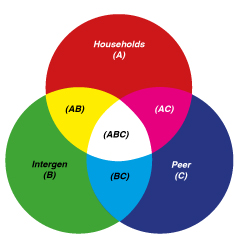Finding the sweet spot
Growing lifelong, active followers of Jesus in:
• households,
• with peers, and/or
• in intergen-relational ways
The Sweet Spot
The term ‘sweet spot’ is often used in a sporting context to describe the relationship between:
- the player,
- the bat, racket, or golf club, and
- the ball.
Just the right alignment and contact, with the right use of power, results in the maximum desired outcome.
Three related ideas
The idea of exploring the relationship between three ideas was born out of an article that encouraged readers to explore the first 4 chapters of Mark’s gospel with 3 coloured pens in hand. Readers were encouraged to use different colours to repectively highlight:
- The Words of Jesus that teach the Truth of God,
- the Works of Jesus that demonstrate the Love of God, and
- the Wonders of Jesus that show the Power of God.
You are invited to try this. You will discover there are plenty of verses marked with single colours and many with overlaps of 2 or 3 colours.
A story
One training session was conducted with the leaders from different churches responsible for Sunday morning ministry with children. Participants were divided into 3 groups and were asked to argue for a curriculum approach that favoured one of the following stances above the other:
- The Truth of God … arguing for Bible story, Bible literacy & knowledge, biblical history, and theology relevant to the age of the child. “We HAVE to teach the Truth!!”
- The Love of God … arguing for the need to connect relationally with one another, showing love & care to one another! Mission and service projects are very important. Did I mention supporting missionaries! “We HAVE to live out God’s love to one another!!”
- The Power of God … arguing that children need to learn to pray, and learn other spiritual disciplines which will help them through all of life. “If we aren’t teaching devotional practices to children while they are young, we aren’t doing our job!!”
The debate became heated in a fun way as these experienced leaders could easily argue from any of the points of view. Later, the group reflection revealed that many of the group did, in fact, have a preferred starting point in their approaches to ministry. Participants revealed they were often pretty settled in this with little consideration of possible changes to include any emphasise on other elements.
The challenge was to then consider approaches that didn’t eliminate the possibilities of other approaches due to personal or denominational preferences, or such things like the time constraints in a particular context.
A further exercise to demonstrate this point was to ask particpants to fill in the blank spaces.
“With limited time for our kid’s program, a shortened lesson means we will just do the [ _______ ] and skip the [ _______ ] bit! OK?”
Christian Swartz
Further to this, material written as a result of research by Christian Swartz and Natural Church Development highlighted this idea of 3 overlapping circles. His ideas also explored the importance of recognising your starting viewpoint and the encouragement to be heading towards the sweet spot of all 3 spheres using a process of learning, planning, action and reflection.
Applying this metaphor (or others like it) to intergen-relational discipleship looks for the maximum desired discipling outcome from the combinations of:
- household faith and life practices,
- peer and single demographic discipleship, and
- intergen-relational activities.
All working in the sweet spot (or, at least, towards the sweet spot) to foster connections, participation, engagement, belonging and faith responses.

Consider 3 overlaping circles
In this diagram, a circle represents a discipling activity. An overlap of circles represents an activity that achieves a combination of involvements on household, peer to peer and/or intergen-relational levels.
- Household faith
- Peer or demographic specific discipleship
- Intergen-relational faith community activities & selebrations of worship


